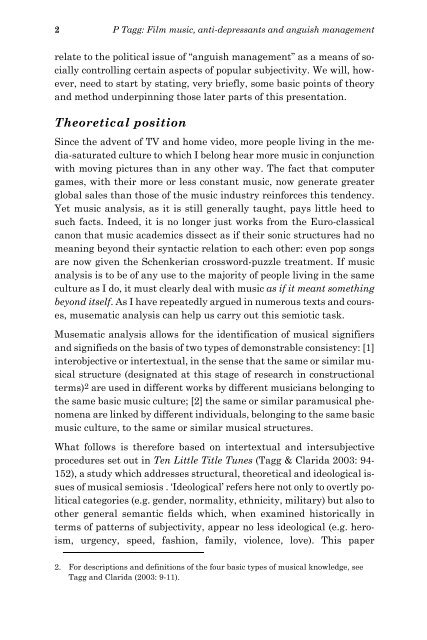Film music, antidepressants and anguish management - Philip Tagg
Film music, antidepressants and anguish management - Philip Tagg
Film music, antidepressants and anguish management - Philip Tagg
You also want an ePaper? Increase the reach of your titles
YUMPU automatically turns print PDFs into web optimized ePapers that Google loves.
2 P <strong>Tagg</strong>: <strong>Film</strong> <strong>music</strong>, anti-depressants <strong>and</strong> <strong>anguish</strong> <strong>management</strong><br />
relate to the political issue of “<strong>anguish</strong> <strong>management</strong>” as a means of socially<br />
controlling certain aspects of popular subjectivity. We will, however,<br />
need to start by stating, very briefly, some basic points of theory<br />
<strong>and</strong> method underpinning those later parts of this presentation.<br />
Theoretical position<br />
Since the advent of TV <strong>and</strong> home video, more people living in the media-saturated<br />
culture to which I belong hear more <strong>music</strong> in conjunction<br />
with moving pictures than in any other way. The fact that computer<br />
games, with their more or less constant <strong>music</strong>, now generate greater<br />
global sales than those of the <strong>music</strong> industry reinforces this tendency.<br />
Yet <strong>music</strong> analysis, as it is still generally taught, pays little heed to<br />
such facts. Indeed, it is no longer just works from the Euro-classical<br />
canon that <strong>music</strong> academics dissect as if their sonic structures had no<br />
meaning beyond their syntactic relation to each other: even pop songs<br />
are now given the Schenkerian crossword-puzzle treatment. If <strong>music</strong><br />
analysis is to be of any use to the majority of people living in the same<br />
culture as I do, it must clearly deal with <strong>music</strong> as if it meant something<br />
beyond itself. As I have repeatedly argued in numerous texts <strong>and</strong> courses,<br />
musematic analysis can help us carry out this semiotic task.<br />
Musematic analysis allows for the identification of <strong>music</strong>al signifiers<br />
<strong>and</strong> signifieds on the basis of two types of demonstrable consistency: [1]<br />
interobjective or intertextual, in the sense that the same or similar <strong>music</strong>al<br />
structure (designated at this stage of research in constructional<br />
terms)2 are used in different works by different <strong>music</strong>ians belonging to<br />
the same basic <strong>music</strong> culture; [2] the same or similar para<strong>music</strong>al phenomena<br />
are linked by different individuals, belonging to the same basic<br />
<strong>music</strong> culture, to the same or similar <strong>music</strong>al structures.<br />
What follows is therefore based on intertextual <strong>and</strong> intersubjective<br />
procedures set out in Ten Little Title Tunes (<strong>Tagg</strong> & Clarida 2003: 94-<br />
152), a study which addresses structural, theoretical <strong>and</strong> ideological issues<br />
of <strong>music</strong>al semiosis . ‘Ideological’ refers here not only to overtly political<br />
categories (e.g. gender, normality, ethnicity, military) but also to<br />
other general semantic fields which, when examined historically in<br />
terms of patterns of subjectivity, appear no less ideological (e.g. heroism,<br />
urgency, speed, fashion, family, violence, love). This paper<br />
2. For descriptions <strong>and</strong> definitions of the four basic types of <strong>music</strong>al knowledge, see<br />
<strong>Tagg</strong> <strong>and</strong> Clarida (2003: 9-11).














